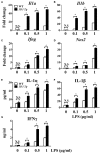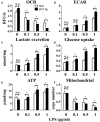Deficiency in IL-33/ST2 Axis Reshapes Mitochondrial Metabolism in Lipopolysaccharide-Stimulated Macrophages
- PMID: 30774633
- PMCID: PMC6367255
- DOI: 10.3389/fimmu.2019.00127
Deficiency in IL-33/ST2 Axis Reshapes Mitochondrial Metabolism in Lipopolysaccharide-Stimulated Macrophages
Abstract
The polarization and function of macrophages play essential roles in controlling immune responses. Interleukin (IL)-33 is a member of the IL-1 family that has been shown to influence macrophage activation and polarization, but the underlying mechanisms are not fully understood. Mitochondrial metabolism has been reported to be a central player in shaping macrophage polarization; previous studies have shown that both aerobic glycolysis and oxidative phosphorylation uniquely regulate the functions of M1 and M2 macrophages. Whether IL-33 polarizes macrophages by reshaping mitochondrial metabolism requires further investigation. In this work, we examined the mitochondrial metabolism of bone marrow-derived macrophages (BMDMs) from either wild type (WT), Il33-overexpressing, or IL-33 receptor knockout (St2-/-) mice challenged with lipopolysaccharide (LPS). We found that after LPS stimulation, compared with WT BMDMs, St2-/- BMDMs had reduced cytokine production and increased numbers and activity of mitochondria via the metabolism regulator peroxisome proliferator-activated receptor-C coactivator-1 α (PGC1α). This was demonstrated by increased mitochondrial DNA copy number, mitochondria counts, mitochondria fission- and fusion-related gene expression, oxygen consumption rates, and ATP production, and decreased glucose uptake, lactate production, and extracellular acidification rates. For Il33-overexpressing BMDMs, the metabolic reprogramming upon LPS stimulation was similar to WT BMDMs, and was accompanied by increased M1 macrophage activity. Our findings suggested that the pleiotropic IL-33/ST2 pathway may influence the polarization and function of macrophages by regulating mitochondrial metabolism.
Keywords: ATP; IL-33; PGC1α; ST2; macrophage.
Figures







Similar articles
-
The IL-33/ST2 axis affects tumor growth by regulating mitophagy in macrophages and reprogramming their polarization.Cancer Biol Med. 2021 Feb 15;18(1):172-183. doi: 10.20892/j.issn.2095-3941.2020.0211. Cancer Biol Med. 2021. PMID: 33628592 Free PMC article.
-
An imbalance of the IL-33/ST2-AXL-efferocytosis axis induces pregnancy loss through metabolic reprogramming of decidual macrophages.Cell Mol Life Sci. 2022 Mar 4;79(3):173. doi: 10.1007/s00018-022-04197-2. Cell Mol Life Sci. 2022. PMID: 35244789 Free PMC article.
-
The interaction between IL-33 and TRIM28 in the regulation of macrophage polarization in an ST2-independent manner.Int Immunopharmacol. 2025 Apr 16;152:114318. doi: 10.1016/j.intimp.2025.114318. Epub 2025 Mar 6. Int Immunopharmacol. 2025. PMID: 40054323
-
IL-33/ST2 Axis in Organ Fibrosis.Front Immunol. 2018 Oct 24;9:2432. doi: 10.3389/fimmu.2018.02432. eCollection 2018. Front Immunol. 2018. PMID: 30405626 Free PMC article. Review.
-
The ST2/Interleukin-33 Axis in Hematologic Malignancies: The IL-33 Paradox.Int J Mol Sci. 2019 Oct 22;20(20):5226. doi: 10.3390/ijms20205226. Int J Mol Sci. 2019. PMID: 31652497 Free PMC article. Review.
Cited by
-
Inflammation-induced mitochondrial and metabolic disturbances in sensory neurons control the switch from acute to chronic pain.Cell Rep Med. 2023 Nov 21;4(11):101265. doi: 10.1016/j.xcrm.2023.101265. Epub 2023 Nov 8. Cell Rep Med. 2023. PMID: 37944527 Free PMC article.
-
ROS-Induced mtDNA Release: The Emerging Messenger for Communication between Neurons and Innate Immune Cells during Neurodegenerative Disorder Progression.Antioxidants (Basel). 2021 Nov 29;10(12):1917. doi: 10.3390/antiox10121917. Antioxidants (Basel). 2021. PMID: 34943020 Free PMC article. Review.
-
Changes in Mitochondrial Transcriptional Rhythms and Depression-like Behavior in the Hippocampus of IL-33-Overexpressing Mice.Int J Mol Sci. 2025 Feb 22;26(5):1895. doi: 10.3390/ijms26051895. Int J Mol Sci. 2025. PMID: 40076523 Free PMC article.
-
The Functional Roles of IL-33/ST2 Axis in Ocular Diseases.Mediators Inflamm. 2020 Aug 18;2020:5230716. doi: 10.1155/2020/5230716. eCollection 2020. Mediators Inflamm. 2020. PMID: 32908451 Free PMC article. Review.
-
Mitochondrial dysfunction as a key player in aggravating periodontitis among diabetic patients: review of the current scope of knowledge.Naunyn Schmiedebergs Arch Pharmacol. 2025 Apr 24. doi: 10.1007/s00210-025-04025-x. Online ahead of print. Naunyn Schmiedebergs Arch Pharmacol. 2025. PMID: 40272516 Review.
References
-
- Palsson-McDermott EM, Curtis AM, Goel G, Lauterbach MA, Sheedy FJ, Gleeson LE, et al. Pyruvate kinase M2 regulates Hif-1alpha activity and IL-1beta induction and is a critical determinant of the warburg effect in LPS-activated macrophages. Cell Metab. (2015) 21:65–80. 10.1016/j.cmet.2014.12.005 - DOI - PMC - PubMed
Publication types
MeSH terms
Substances
LinkOut - more resources
Full Text Sources

